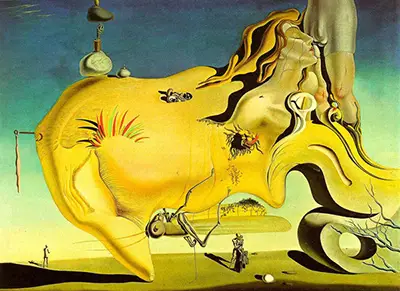The painting is on display at the Museo Nacional Centro de Arte Reina Sofía, in the Spanish capital of Madrid.
A large oil on canvas painting, it is full of the themes and ideas Dali commonly explored. To anybody who knows even a small amount about his paintings, this imagery will be instantly recognisable when looking at the Great Masturbator.
It is full of thinly-veiled symbolism, curved "melting" lines, figures and faces. Objects appear where they wouldn't usually be seen, the environment both alien yet recognisable. It is a self-exploratory dreamworld, with Dali exposing his innermost conflicts.
Much of the painting is dominated by a face, eyes closed, the nose balancing precariously on the ground. This profile is said to be a self-portrait of the artist, and also based on a real rock that can be found at Cape Ceres, on the Catalan coastline.
The Persistence of Memory (1931), arguably one of Dali's most famous paintings, is based around a very similar facial form.
A female figure rises from the face, almost universally agreed to be Dali's great love, Gala. Gala was of Russian descent and raised in a family of intellectuals. She was heavily intertwined in the surrealist movement from a young age, and she was a muse to many artists of the genre. She became the wife of the French surrealist poet Paul Éluard in 1917.
Gala and Dali quickly embarked upon a relationship when meeting for the first time in 1929 (the same year the Great Masturbator was completed) despite the fact that she was still married to Éluard.
Gala inspired and featured in many of Dali's paintings, including Portrait of Galarina (1940–45), Galatea of the Spheres (1952) and The Discovery of America by Christopher Columbus (1959), to name but a few.
The female appears to be thrusting upwards towards the sexual organs of a male figure, as if some oral gratification is about to occur. His head and upper torso can not be seen, and his knees appear newly scratched and bleeding.
A singular lily can be seen at the female's breasts, adding to the phallic imagery.
For all the obvious sexual expression in the Great Masturbator, Dali had a complicated association with sexuality, masturbation and genitalia, and this painting explores much of this.
The unpredictable and jumpy grasshopper gripping on to the face represents his anxieties and discomfort. The insect appears in a number of his works.
An ant colony adds to the atmosphere of uneasiness and tension.
As well as the previously mentioned blood, there is a cracked face, and eruptions from the skin. Figures can be seen beneath the main visage. A couple embracing seem to be oblivious to the torment happening above and around them.
Dali was experiencing somewhat of a metamorphosis in his personal life at the time of painting.
The whirlwind of hormones and emotions wrapped up in Gala being catapulted into his life and the complications of his personal psychology regarding all matters sexual - The Great Masturbator is a somewhat voyeuristic gaze into Dali's thought process.
The Great Masturbator is a fine example of surrealist art, with much to analyse and explore. It is a bold image despite the shades being complimentary, and beautiful despite the discomfort it portrays. It is a very important painting, being one of the first to showcase Dali's many talents and visions.

